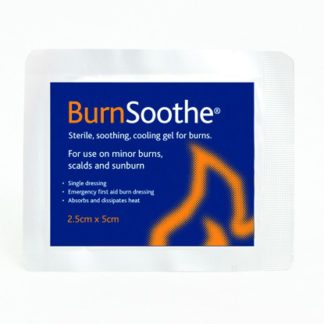Description
BurnSoothe Burns Dressing
Sterile in its own individual packaging
2.5 cm x 5 cm
Soothing, cooling, non-toxic burn gel
Guaranteed sterile and burn safe
Fast-acting easy-to-use Burnsoothe burns product
Treating burns and scalds
Appropriate first aid must be used to treat any burns or scalds as soon as possible. This will limit the amount of damage to your skin.
You can apply the following first aid techniques to yourself or another person who has been burnt.
First aid for burns
Stop the burning process as soon as possible. This may mean removing the person from the area, dousing flames with water, or smothering flames with a blanket. Don’t put yourself at risk of getting burnt as well.
Remove any clothing or jewellery near the burnt area of skin, including babies’ nappies. However, don’t try to remove anything that’s stuck to the burnt skin as this could cause more damage.
Cool the burn with cool or lukewarm running water for 20 minutes, as soon as possible after the injury. Never use ice, iced water, or any creams or greasy substances such as butter.
Keep yourself or the person warm. Use a blanket or layers of clothing, but avoid putting them on the injured area. Keeping warm will prevent hypothermia, where a person’s body temperature drops below 35C (95F). This is a risk if you are cooling a large burnt area, particularly in young children and elderly people.
Cover the burn with cling film. Put the cling film in a layer over the burn, rather than wrapping it around a limb. A clean clear plastic bag can be used for burns on your hand.
Treat the pain from a burn with paracetamol or ibuprofen. Always check the manufacturer’s instructions when using over-the-counter medication. Children under 16 years of age should not be given aspirin.
Sit upright as much as possible if the face or eyes are burnt. Avoid lying down for as long as possible as this will help to reduce swelling.
When to go to the hospital
Once you have taken these steps, you’ll need to decide whether further medical treatment is necessary. Go to a hospital accident and emergency (A&E) department for:
large or deep burns – bigger than the affected person’s hand
burns of any size that cause white or charred skin
burns on the face, hands, arms, feet, legs or genitals that cause blisters
all chemical and electrical burns
Also get medical help straight away if the person with the burn:
has other injuries that need treating
is going into shock – signs include cold, clammy skin, sweating, rapid, shallow breathing, and weakness or dizziness
is pregnant
is over the age of 60
is under the age of five
has a medical condition such as heart, lung or liver disease, or diabetes
has a weakened immune system (the body’s defence system) – for example, because of HIV or AIDS, or because they’re having chemotherapy for cancer
If someone has breathed in smoke or fumes, they should also seek medical attention. Some symptoms may be delayed, and can include:
coughing
a sore throat
difficulty breathing
singed nasal hair
facial burns
NHS Choices
Do You Have a Question about This Product – Ask Wessex





Reviews
There are no reviews yet.